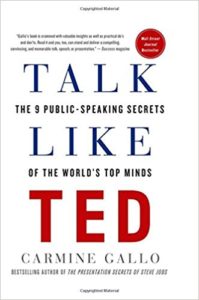Conversational Blogging Takes Practice – Part B

Counter-intuitive as that may seem, Gallo explains, “Conversational delivery takes practice,” Gallo stresses in Talk Like TED, tracing the creation of a Dr. Jill presentation in Indianapolis.
As a content writer for marketing blogs, I often explain to clients and to newbie writers that that blogs (compared to, say, brochures, white papers, and newsletters) are casual and conversational. In fact, that’s precisely what makes it convenient for companies and professional practitioners to use blogs to achieve the frequency needed to win online search engine ranking.
But, as Gallo so aptly points out about the Dr. Jill TED talk, “conversational” still takes practice. The point I want to make is that the steps Dr. Jill used in preparing for her talk can be extremely valuable in blog content writing. Earlier this week, I discussed idea generation and the method any serious blog writer must develop for capturing ideas – from conversations, magazines, radio, billboards, for later blog post content. After typing out her longhand notes, Dr. Jill condensed the material into major points. Gathering ideas, then selecting one central concept to emphasize in each post are each vital steps in blog marketing.
Having honed her ideas and condensed the content, the next step for Dr. Jill was perhaps the most challenging – figuring out how to deliver the message. “Great speakers act out a story,” Gallo says, noting that Dr. Jill “weighs the entertainment component of her presentation as equally as she does the others.” In fact, Gallo’s opinion is that “the problem with most technical or scientific discussions is that presenters fail to make their content visual, interesting, and entertaining.”
When it comes to business marketing blogs, a true content contribution solves customer problems in three ways:
- by educating
- by informing
- by entertaining
While good blog posts can and should be entertaining, most online searchers are not pursuing a recreational activity, but instead are on a fact-finding mission. On the other hand, images can go a very long way in adding excitement and interest.
Dan Hughes of jtvdigital observes that “In this day and age, pictures and video are powerful promotional tools that cater to the attention span of the modern digital consumer.” However, Hughes continues, “well-crafted copy is an essential part of success.”
Conversational blogging may not take all the prep time of a TED talk, but it certainly takes practice!




Follow us online!